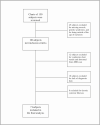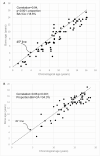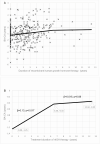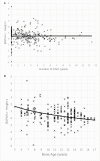Long-term GH Therapy Does Not Advance Skeletal Maturation in Children and Adolescents
- PMID: 33860132
- PMCID: PMC8035984
- DOI: 10.1210/jendso/bvab036
Long-term GH Therapy Does Not Advance Skeletal Maturation in Children and Adolescents
Abstract
Context: There is no consensus on the effect of recombinant human GH (rhGH) therapy on skeletal maturation in children despite the current practice of annual monitoring of skeletal maturation with bone age in children on rhGH therapy.
Aims: To investigate the effects of long-term rhGH therapy on skeletal age in children and explore the accuracy of bone age-predicted adult height (BAPAH) at different ages based on 13 years of longitudinal data.
Methods: A retrospective longitudinal study of 71 subjects aged 2 to 16 years, mean 9.9 ± 3.8 years, treated with rhGH for nonsyndromic short stature for a duration of 2 to 14 years, mean, 5.5 ± 2.6 years. Subjects with syndromic short stature and systemic illnesses such as renal failure were excluded.
Results: Bone age minus chronological age (BA-CA) did not differ significantly between baseline and the end of rhGH therapy (-1.05 ± 1.42 vs -0.69 ± 1.63, P = 0.09). Piecewise regression, however, showed a quantifiable catch-up phenomenon in BA of 1.5 months per year of rhGH therapy in the first 6.5 years (P = 0.017) that plateaued thereafter (P = 0.88). BAPAH overestimated near-adult height in younger subjects but became more accurate in older subjects (P < 0.0001). IGF-I levels correlated significantly with increases in child's height and BA-CA.
Conclusion: Long-term rhGH therapy demonstrated an initial catch-up phenomenon in skeletal maturation in the first 6.5 years that plateaued thereafter with no overall significant advancement in bone age. These findings are reassuring and support strategic, but not the insurance company mandated reflexive annual monitoring of skeletal maturation with bone age in children receiving rhGH therapy.
Keywords: bone age; growth hormone deficiency; height velocity; short stature.
© The Author(s) 2021. Published by Oxford University Press on behalf of the Endocrine Society.
Figures





Similar articles
-
Responses to growth hormone (GH) therapy in short children with normal GH secretion and no bone age delay: an analysis of potential factors affecting their response to rhGH therapy. A controlled study.Acta Biomed. 2019 Sep 23;90(8-S):43-51. doi: 10.23750/abm.v90i8-S.8506. Acta Biomed. 2019. PMID: 31544806 Free PMC article.
-
Short-term therapy with recombinant growth hormone in polytransfused thalassaemia major patients with growth deficiency.J Pediatr Endocrinol Metab. 1998;11 Suppl 3:845-9. J Pediatr Endocrinol Metab. 1998. PMID: 10091155
-
[Efficacy and safety of recombinant human growth hormone solution in children with growth hormone deficiency in China: a multicenter trial].Zhonghua Er Ke Za Zhi. 2009 Jan;47(1):48-52. Zhonghua Er Ke Za Zhi. 2009. PMID: 19573383 Clinical Trial. Chinese.
-
Growth velocity, final height and bone mineral metabolism of short children treated long term with growth hormone.Curr Pharm Biotechnol. 2000 Jul;1(1):33-46. doi: 10.2174/1389201003378997. Curr Pharm Biotechnol. 2000. PMID: 11467359 Review.
-
The growth hormone cascade: progress and long-term results of growth hormone treatment in growth hormone deficiency.Horm Res. 1998;49 Suppl 2:41-57. doi: 10.1159/000053087. Horm Res. 1998. PMID: 9730672 Review.
Cited by
-
Clinical and laboratory characteristics but not response to treatment can distinguish children with definite growth hormone deficiency from short stature unresponsive to stimulation tests.Front Endocrinol (Lausanne). 2024 Mar 1;15:1288497. doi: 10.3389/fendo.2024.1288497. eCollection 2024. Front Endocrinol (Lausanne). 2024. PMID: 38495788 Free PMC article.
References
-
- Wilson DM. Regular monitoring of bone age is not useful in children treated with growth hormone. Pediatrics. 1999;104(4 Pt 2):1036-1039. - PubMed
-
- Crowe BJ, Rekers-Mombarg LT, Robling K, Wolka AM, Cutler GB Jr, Wit JM; European Idiopathic Short Stature Group . Effect of growth hormone dose on bone maturation and puberty in children with idiopathic short stature. J Clin Endocrinol Metab. 2006;91(1):169-175. - PubMed
-
- Zadik Z, Chalew S, Zung A, et al. Effect of long-term growth hormone therapy on bone age and pubertal maturation in boys with and without classic growth hormone deficiency. J Pediatr. 1994;125(2):189-195. - PubMed
-
- Darendeliler F, Ranke MB, Bakker B, et al. Bone age progression during the first year of growth hormone therapy in pre-pubertal children with idiopathic growth hormone deficiency, Turner syndrome or idiopathic short stature, and in short children born small for gestational age: analysis of data from KIGS (Pfizer International Growth Database). Horm Res. 2005;63(1):40-47. - PubMed
LinkOut - more resources
Full Text Sources
Other Literature Sources
